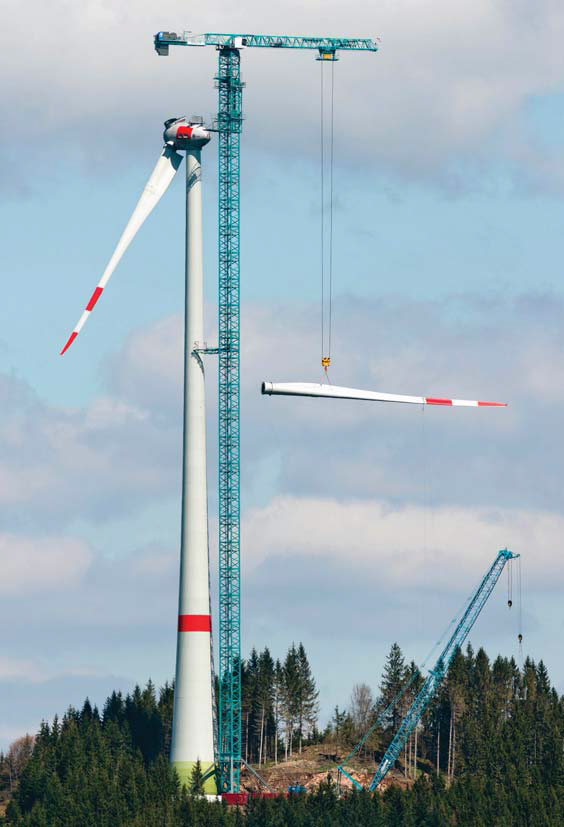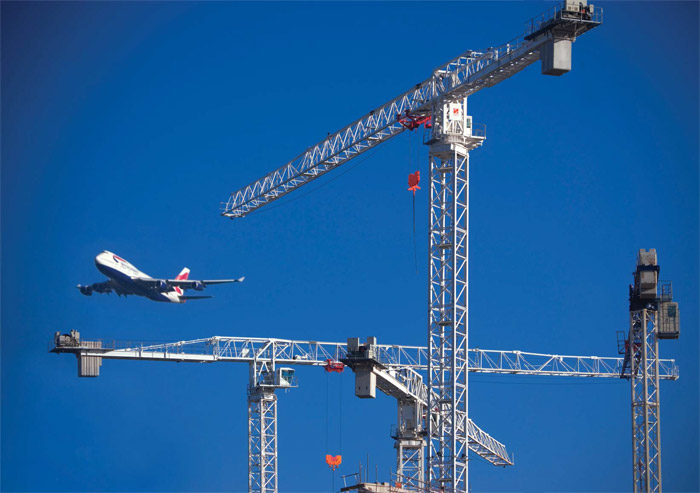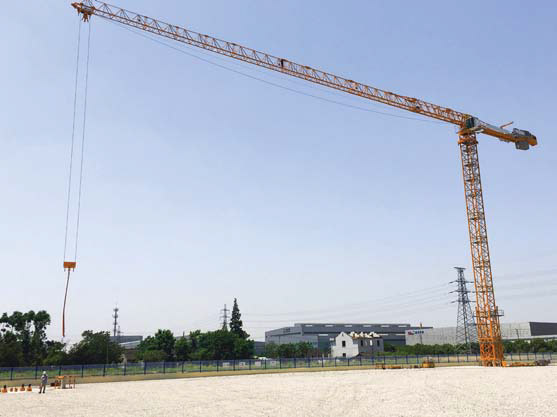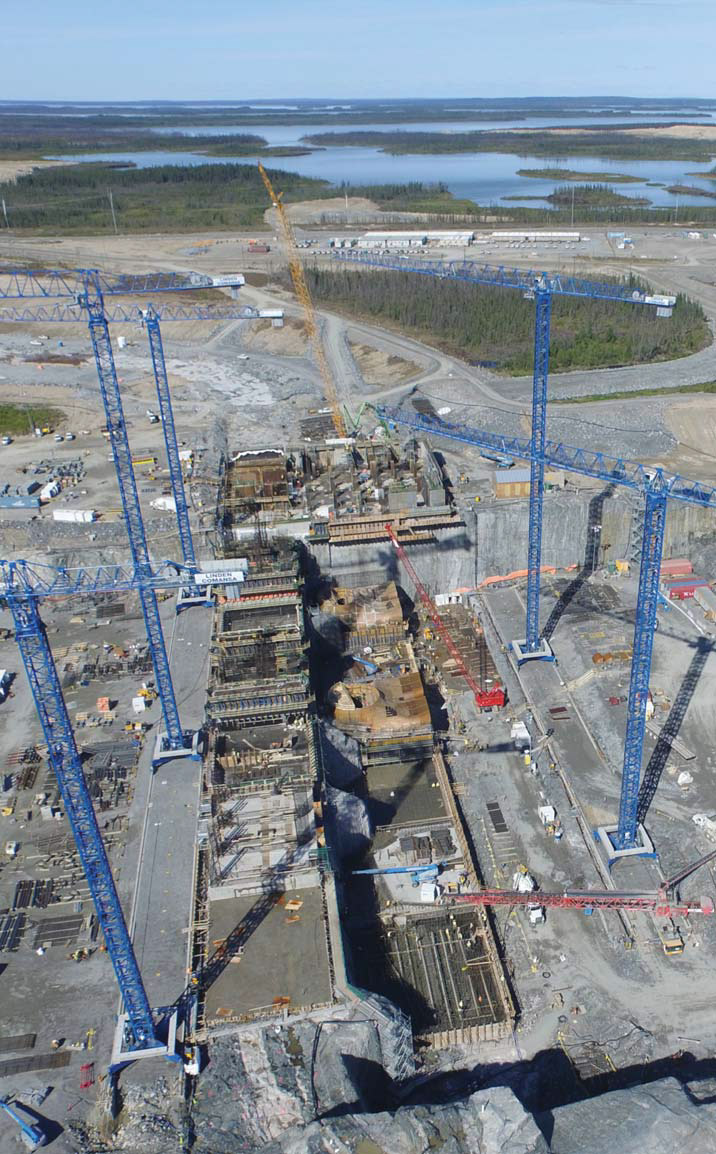Flat tops power up
14 February 2019Large-capacity tower cranes used to be hammerheads or luffers. Now flat-top tower cranes are increasing their lifting power and finding new applications. Julian Champkin reports.
Large-capacity tower cranes used to be hammerheads or luffers. Now flat-top tower cranes are increasing their lifting power and finding new applications. Julian Champkin reports.
Tower cranes dominate the market in construction and have done for many years. In congested cities, for high-rise buildings, where available footprints are small, lift distances are large, and projects are costly, they are the obvious and almost universal solution. In recent years though, changes within the tower crane market have become apparent. The traditional hammerheads have been ceding ground and market share.
Tower luffers have taken some of that share; but flat-tops, also called topless cranes, have taken more, and increasingly are preferred.
Several factors make flattops desirable. Having no superstructure means that they can be used closely together: the jib of one crane can pass under that of its neighbour with less height clearance needed to avoid collisions. Thus for multi-crane projects they have an advantage. Ease and simplicity of erection is another plus. Flat-tops lack the A-frame or cat-head above the tower, and lack also the pendant lines that connect the top of the A-frame to the jib and counterjib.
The absence of the extra metalwork and bracing simplifies erection and means that they can be assembled on-site more easily and more quickly. “They can be shipped in small structure elements that can easily reach the right spot within the facilities and be quickly erected,” says Mariano Echavarri of flat-top specialists Comansa. Hence their increasing use.
One disadvantage, though, is that the A-frames and pendant lines of conventional tower cranes impart strength. Lacking this bracing means that flat-tops lift comparatively less than traditional hammerhead tower cranes.
However, this has begun to change. Flat-tops with large, sometimes with very large, lifting capacities have started to appear. 8t–10t used to be considered the norm, and those capacities still dominate the market; but flatheads capable of lifting 32t, and even 40t and 50t, are available.
Among western manufacturers Liebherr, Comansa, Potain and Terex all now have flat-tops capable of lifting 32t and over, and Italian makers ENG have their 40t ETT 791; Chinese manufacturer Yongmao is with them, and its large flat-tops cranes can be found in prestige projects in Europe as well as in the rest of the world.
Comansa launched the 50t-capacity 21LC1050 in September 2018, and in November 2018 applied some of the design features of that crane to its 21LC660 and 21LC750 models to update them and increase their maximum load capacities to 25t, 37.5t, and 50t depending on the version. Potain launched its largest topless yet, the MCT 565, with maximum capacity of 32t, also in September 2018. And, Liebherr has a supersized flattop, the 1000 EC-B, in 100t and 125t maximum capacities.
As with most developments in the crane industry, the arrival of large flat-tops has been driven by the needs and demands of users. “It was the market that was demanding this type of crane,” says Echavarri.
“The large capacity cranes from Comansa are mainly designed to work in all types of large industrial projects, like power plants or mines, where the cranes can work not only in the construction of the premises but also for maintenance or expansions.
“These models are recently being quite successful in shipyards, especially in northern Europe. In most cases they are on a portal and travelling system, which is a good solution to gain efficiency, save physical space and allow traffic underneath the crane.”
Windfarms are another application. A fully-assembled set of turbine blades can weigh 70t; Liebherr proudly point to the suitability of its 125t Litronic 1000 EC-B 125 for such uses.
In April 2018, Yongmao had its 64t capacity STT 1330-64, claimed to be the largest in Finland, working on a new terminus at Helsinki airport. City Lifting has had its own record breaking flat-top, a 50t Comansa 21LC750, which they say is the biggest in the UK, at work at Heathrow building a hotel next to Terminal 2.
It is not a coincidence that both of these large flat-tops have been used at airports: clearance below flight paths is an obvious factor there.
Architects will want to design their buildings with rooflines as high as is safe for planes to overfly. A hammerhead tower crane with an A-frame will of course be considerably higher than the roof it is erecting; a flat-top will exceed it by far less.
The CTT 561 A-32 from Terex has a capacity of 32t. Its CTT 721- 40 can lift 40t. Angelo Cosmo is product marketing manager for Terex tower cranes. “It is an interesting market,” he says. “We see a lot of these cranes in the Middle East, Northern Europe, and in the US, but the market is defined more by the job requirement than by geographical area.”
Echavarri makes the same point: “Scandinavia is probably where our large flat-tops have had most success but Comansa has sold them to all continents,” he says.
Cosmo again: “In general the tower crane market is moving towards flat-tops rather than A-frame, because of their benefits, and that applies across the size range. Other applications for high capacity flat-tops are for nuclear power-plants, for infrastructure, and for high-rise residential buildings.” The latter use has been particularly driven by the increasing use of pre-cast concrete units for cladding and modular construction in general. These weigh far more than glass cladding panels and demand higher-capacity cranes.
It is a demand that is particularly apparent in Asia, thanks to recent moves by the Chinese government. In a bid to speed construction of much-needed residential property, and also to ease a shortage of skilled construction labour, it has been promoting precast cladding for tall buildings. “For that reason demand for tower cranes has changed,” says Jonas Tan, director of Yongmao. “18t or 20t used to be considered a large-capacity crane. Now users are wanting more.”
Other makers of cranes in Asia or for the Asian market have not been slow to respond.
Singapore has gone even further than China, in that its government is encouraging PPVC, which stands for prefabricated prefinished volumetric construction. Entire rooms, such as bathrooms complete with plumbing, are prefabricated in factories and lifted into the high-rise shell. “The 21LC1050 is already in high demand in Asia in markets where PPVC construction is generalizing,” says Echavarri. It is a sign of the Asian interest that both the Comansa and the Potain large flat-tops were launched at Bauma Shanghai.
“Loads are getting bigger,” said Thibault le Besnerais, Potain’s global product director for tower cranes, at the same event, “which means capacities are getting larger as well.”
Even so, demand for very large capacity flat-tops is not yet great— at least in proportion to the rest of the tower crane market. “We have demand for 30-40t flat-tops,” says Cosmo; “but for sure it does not compare with the small/medium ones.
It does not even come close. At a guess, I would say that 40% of the flat-top and hammerhead market is in the 8t–12t range. Our range is up to 40t; but the higher you go, the less the demand. When you go higher than 40t, the niche gets even smaller, and those cranes are designed for specific jobs. So currently this really is a niche market
“We do design cranes in that range. If a special customer needs such a crane for a special job, we will design and make it for him, we do care about our customers; but usually those cranes do not get into the serial production line.”
Comansa thinks similarly: “The type of projects in which these cranes work are usually large, complex and have special requirements,” says Echavarri. “We want to stay close to our customers and understand their problems, so we can provide the solutions. Most of the times, these projects are a challenge for us, but all the knowledge that the Comansa team learns from one of them can be applied in the following one, adding an extra value to our services.”
Flat tops do have one design advantage over hammer-heads. The pendant lines of a traditional hammerhead meet and support the jib about half-way along its length. This divides the jib when loaded into two different stress regimes. The portion inboard of the pendant line attachment point is supported at both ends; the portion beyond the pendant line is supported at only one end, while the far end takes the load.
The inboard portion may be trying to flex either upwards or downwards, depending on where the trolley is and on how much of the load is being taken by the pendant line. Its metalwork will be being stretched or compressed accordingly. Alternating regimes of tension and compression are undesirable: they are a prime cause of metal fatigue and failure.
This is a danger that hammer-head designers must take into account. On a flat-top, the whole of the jib is in a single regime, that of being supported at the inboard end only.
This means that the lower member of the jib is always in compression, and its upper member is always in tension. The behaviour of the jib under load is therefore much more predictable. There is no compression/tension alternation, so metal fatigue from that cause ceases to be a design issue, and the likelihood of failure, of the girders or of a connecting pin, is very much less. The simpler design has greatly reduced the danger.
“Major fatigue is avoided due to the fact that upper chord is always working under traction forces. There are no reverse fatigue cycles such as happen in pendant-line cranes,” is how Echavarri explains it.
Nevertheless, building a high capacity flat-top is not simply a matter of making everything bigger.
“The design problems that our engineering office has to overcome are mainly issues related to product transportation,” says Echavarri.
“Economical sea freight is usually limited by the maximum container height which is something lower than 2.6m. To overcome this handicap, in the LC3000, our largest flat-top series to date, our engineers developed foldable jib sections.
In this smart way the jib sections of almost 6m height are easily transported and are assembled in the working area by just unfolding hinged panels. The concept was also patented at the time.”
Cosmo adds this: “A detailed analysis has to be done, from structures to winches and transportation. If the customer is ready to invest for this, if his job makes it worthwhile, you can go ahead.”
It is not always maximum capacity that is required. “It often happens that we must redefine the load chart,” he says. “This does not necessarily mean we increase the maximum capacity, but we tailor the crane to the specific job site.”
Similarly, Comansa has its PowerLift system of control and moment limitation, which improves the load diagram by up to 10%. “It works at reduced speeds,” says Echavarri, “increasing the loading capacity for jobs that require it, and is activated by the crane operator from the cabin. For example, the 21LC1050 with full jib of 80m can load its maximum capacity of 50t to a maximum radius of 18.6m. If needed, the operator could activate the PowerLift system and move such load to a maximum radius of 20.1m.”
“There could be no limit to design capability,” says Cosmo. “The limiting factor instead is investment: Does the end cost and value of the crane sit well into the completed project?”
So, it is not impossible that still larger flat-tops may appear. “We are discussing a lot internally about making them bigger still,” he says.
“It is a question of priorities. We cannot say yet when it would happen. Every year the markets change, and we do our best to adapt..”
Ultimately, he says, demand for large flat-tops, and hence supply of large flat-tops, depends not on the crane manufacturers but on architects.
"Tower cranes are primarily for vertical buildings. We cannot control that basis of our business. Architects and contractors are the ones who determine the basis of the business. Increasing heights of buildings, challenging shapes, demanding production schedules are some of the needs we need to meet. We are here to support the construction business.”
A 125t flat-top for wind farms
The 1000 EC-B 125, Liebherr’s most powerful fl at-top, has been used for wind turbine erection in the Black Forest. The crane lifts up to 125t when using six lines. On this job, it was used in four-line mode for a maximum capacity of 100t. The wind turbine was to be built altitude of around 800m in hills between the towns of Gutach and Mühlenbach in the Black Forest, with the project calling for minimal forest clearance.
Enercon had never before assembled the crane to such a height. With a hub height of 149 m and a blade diameter of 115m, this was the largest turbine ever to be erected using this crane.
The area required for erecting a complete flat-top crane is approximately half of the normal standing area of other crane systems. The jib used in this case was very short, at just 31.5m, which is why no additional site clearance work was required for its assembly.
The logistics required to transport the crane are much less than for comparable crane systems, since the various components of the tower crane are supplied in small packages. The jib components of the large crane can be inserted into the tower elements, transported on a truck and assembled on site.
The crane was climbed to 110m, and then guyed to the turbine tower at a height of 100m. Using this single guying, the crane climbed to a final hook height of 164m. The erection of the wind turbine took around four weeks.




